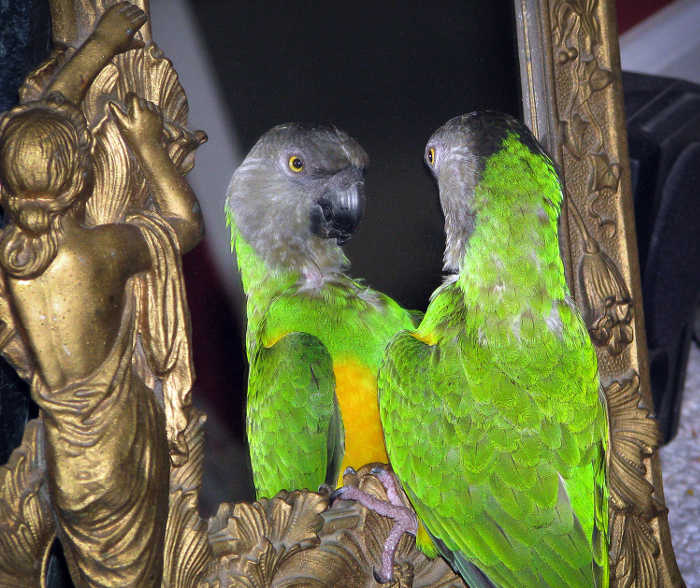FWP:
SETS == INEXPRESSIBILITY;
IZAFAT; WORDPLAY
MIRROR: {8,3}
WRITING: {7,3}
For background see S. R. Faruqi's choices. This verse is NOT one of his choices; mostly for the sake of completeness, I have added it myself. For more on Ghalib's unpublished verses, see the discussion in {4,8x}.
This is a verse in which the beloved is imagined as an adolescent boy; for others, see {9,2}.
The combination of parrots and mirrors seems to bring out the maximally abstract side of Ghalib's temperament. At the center of the present verse is ḳhat̤t̤ , which means 'writing', 'down on the cheek', or any 'line, mark' (see the definition above). In the sense of 'writing', it has an affinity with 'reckoning/writing' and with 'page'. Its sense of 'down on the cheek' is the primary meaning used in the verse. And in the sense of 'line, mark', it can't help evoking-- since the verse contains a 'mirror'-- the countless small 'polish-marks' [jauhar] that necessarily appear over time on any metal mirror. (On this jauhar see {5,4}.)
A prose paraphrase of this verse would seem to be, 'We didn't/couldn't record our amazement at the line of down on the beloved's cheek; the passive page didn't become activated by containing our writing-- it remained an inert mirror, stupefied by amazement, that didn't display the movements of a parrot who was speaking in front of it'. Mirrors frequently show their own 'amazement' (on the special nature of ḥairat see {51,9x}) at the beauty displayed in them, by exactly this inertness and stupefaction; see for example {63,1}.
Gyan Chand gives a helpful explanation of the mirror-based training process that is used for parrots, and that seems to underlie the imagery of the second line. For other parrot-and-mirror verses, see {29,2}.
This verse is aggravating: it seems that if we could just put the imagery together a bit more subtly, and manipulate all those words and ideas more cleverly, something fascinating and deep would emerge. But as far as I can tell, nothing that's worth the effort ever does emerge. We're left with 'we were unable to describe/record the amazing beauty of the down on the beloved's cheek', plus a lot of cleverly interrelated wordplay. This is something worth having, of course; it's just not Ghalib at his smashing, irresistible best.
Note for meter fans: This meter can alternatively begin with
a short syllable instead of a long one. That's the case here, so there's no
need to take the initial nah as the variant ne
(as for example in {169,2}).

Asi:
The amazement of the down on the beloved's cheek could not be written by us. The page, because of amazement, became a mirror. But the mirror was not able to become a parrot-- that is, we were amazed and could not describe the down on the cheek.
== Asi, p. 55